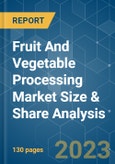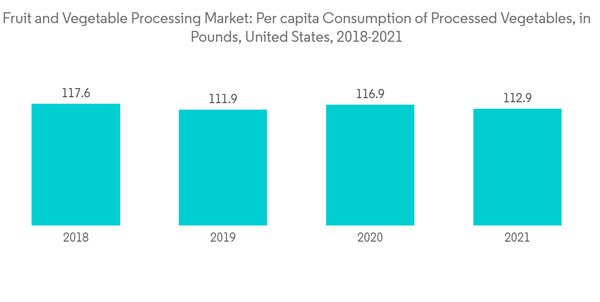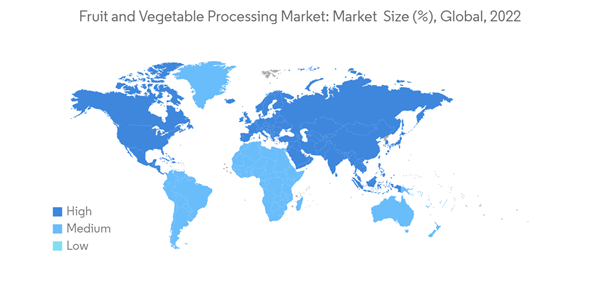The Fruits And Vegetables Processing Market size is expected to grow from USD 63.72 billion in 2023 to USD 76.42 billion by 2028, at a CAGR of 3.70% during the forecast period (2023-2028).
Over the medium term, changing consumer patterns, in terms of dietary habits, due to the influence of Western culture have fueled the demand for fruit and vegetable processing. Thus, companies are developing many products, such as cold-pressed fruits and vegetables, to meet the demand for plant-based products. This is mainly due to consumers' preference for products that have a longer shelf life and easy-to-store properties when compared to fresh fruits & vegetables that are commonly available in the market.
The processed food market is driven by the increase in the need for convenience due to busy customer lifestyles. Further, growth in per-capita income has resulted in greater demand for ready-to-eat and on-the-go food items. This, in turn, has led to an increase in demand for processed fruit and vegetable products. The busy lifestyles of consumers across major cities and other places have significantly impacted the market as they prefer to reduce visits to retail establishments to save time.
Moreover, products that are labeled as organic, and free from various allergen contents are gaining importance in the market for their natural and nutritonal value. Manufacturers in the market tend to process these products in various techniques to maintain their nutritoinal profiles as it is post processing. Freeze drying, Freezing, and Fresh cutting are among the commonly preferred techniques by the manufacturers in the market.
Fruits And Vegetables Processing Market Trends
Adoption of Energy-efficient Food Processing Equipment
As per the US Energy Information Administration, food processing held a share of 4% of global industrial energy consumption, and it is projected to remain the same in 2040. This has led many key players in the food industry to shift toward energy-efficient and multi-functioning food processing equipment that may reduce operational costs and lead to sustainable product development. Companies like Tetra Pak have developed advanced equipment solutions that enable beverage manufacturers to carbonize cost-efficiently. Increasing energy-efficient equipment, increasing the safety of the equipment, and minimizing the cost of maintenance are some of the critical factors that drive the growth of the food processing machinery market. Beverage processing increasingly calls for flexibility in terms of compact design and the ability to switch between products with minimum possible downtimes.
With a widespread inclination towards convenience processed fruits and vegetables are preferred by consumers in the market to compensate for the nutrient intake. Hence, the demand for processed fruits and vegetables is expected to grow resulting in the flourishing of the fruit and vegetable processing market in the coming years.
Growth in North America is Stipulated to Flourish
North America remains the dominant region owing to the increasing import of processed fruits and vegetables and also the growing awareness regarding the benefits of consuming fruits and vegetables, and high consumer spending on convenience foods will steer the product demand across the North American market. Furthermore, consumers demand canned and other processed fruits and vegetables due to their comparatively longer shelf lives than fresh produce. There are numerous companies manufacturing fruits and vegetable processing machinery in the United States, Canada, and other countries. Most of these manufacturers are small and medium enterprises (SMEs), but many large, public companies and iconic American brands trade on a global scale. For example, Excalibur offers dehydrators to dry fruits, vegetables, and leafy greens for healthy snacks, and different types of shelf-stable foods and safe to eat at home. Besides the end-market demand, the high cost of labor in the United States, low labor retention rates, and immigration policies are anticipated to accelerate the need for innovation and equipment automation with improved functionality.
Fruits And Vegetables Processing Industry Overview
Competition between companies in the fruits and vegetables processing industry is chiefly based on price, though companies have been striving to increase the diversity of their product range offering to remain attractive to retailers, leverage brand position, and increase capacity utilization. The global processed fruits and vegetable industry is competitive, and key players include Dole Food Company Inc., Agrana, Archer Daniels Midland Company, Conagra Foods, B&G Foods, Kraft Heinz Company, Nestlé S.A., Albertsons Companies Inc., Olam International, and SVZ International. The companies have been focused on innovations in packaging, changing or reducing the number of ingredients, touting the health and freshness of their ingredients, and creating more innovative items in the fruits and vegetable segment.
Additional Benefits:
- The market estimate (ME) sheet in Excel format
- 3 months of analyst support
Table of Contents
Companies Mentioned (Partial List)
A selection of companies mentioned in this report includes, but is not limited to:
- Agrana
- Archer Daniels Midland Company
- Nestle
- Conagra Foods
- B&G Foods
- Kraft Heinz Company
- Albertsons Companies Inc.
- SVZ International
- OLAM International










